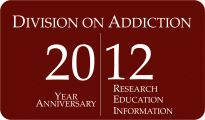Kudos To The Division On Addiction On Its 20th Anniversary!

Dr. Howard Shaffer, director of the Division on Addiction at Cambridge Health Alliance, a Harvard Medical School teaching affiliate, spoke on the subject ofresearch revolutions in gambling disordersat last year’s National Council on Problem Gambling annual conference. Although he was discussing new trends in gambling research, “revolution” is also an apt term to describe the work of Dr. Shaffer and his colleagues at the Division on Addiction, which is celebrating its 20th anniversary this year.
Although gambling research is just one of many areas that the Division on Addiction studies, it is a field in which Dr. Shaffer and associates have been responsible for many “firsts” that have revolutionized the field of gambling research with their seminal studies:
- The first reliable prevalence estimates for gambling disorders in the U.S. (Kessler et al., 2008; Shaffer, Hall & Vander Bilt, 1999)
- The first national study of college gambling and college gambling policies—these studies provided the grounding for theTask Force on College Gambling PoliciesandCollegeGambling.org(LaBrie, 2003; Shaffer, Donato, LaBrie et al., 2005)
- The first longitudinal study of casino employees’ health risks (Shaffer & Hall, 2002)
- The first study of Internet gambling based on the actual transactions of online bettors (LaBrie, LaPlante, Nelson et al., 2007)
- The first studies to conceptualize gambling as a public health issue (Shaffer & Korn, 2002)
- The first attempt to analyze the effect of adaptation when looking at how communities adapt to new forms of gaming (LaPlante & Shaffer 2007)
This list includes just a few of the pioneering studies undertaken by the Division on Addiction over the past 20 years, and the NCRG is proud to have been a partner in many of these ventures. It reminds us that science is about having the courage to take the road less traveled. We encourage readers to visitwww.divisiononaddictions.organd celebrate the 20thanniversary of the Division on Addiction.
References
Kessler, R. C., Hwang, I., LaBrie, R., Petukhova, M., Sampson, N. A., Winters, K. C., et al. (2008). DSM-IV pathological gambling in the National Comorbidity Survey Replication.Psychological Medicine, 38(9), 1351-1360.
Labrie, R. A., Laplante, D. A., Nelson, S. E., Schumann, A., & Shaffer, H. J. (2007). Assessing the playing field: A prospective longitudinal study of internet sports gambling behavior.Journal of Gambling Studies,23(3):347-62.
LaBrie, R. A., Shaffer, H. J., LaPlante, D. A., & Wechsler, H. (2003). Correlates of college student gambling in the United States.Journal of American College Health, 52(2), 53-62.
LaPlante, D. A., & Shaffer, H. J. (2007). Understanding the influence of gambling opportunities: Expanding exposure models to include adaptation.American Journal of Orthopsychiatry, 77(4), 616-623.
Shaffer, H. J., Donato, A. N., LaBrie, R. A., Kidman, R. C., & LaPlante, D. A. (2005). The epidemiology of college alcohol and gambling policies.Harm Reduction Journal, 2(1), 1.
Shaffer, H. J., & Hall, M. N. (2002). The natural history of gambling and drinking problems among casino employees.Journal of Social Psychology, 142(4), 405-424.
Shaffer, H. J., Hall, M. N., & Vander Bilt, J. (1999). Estimating the prevalence of disordered gambling behavior in the United States and Canada: a research synthesis.American Journal of Public Health, 89(9), 1369-1376.
Shaffer, H. J., & Korn, D. A. (2002). Gambling and related mental disorders: A public health analysis.Annual Review of Public Health, 23, 171-212.
NCRG staffICRG NewsaddictionsanniversaryCambridge Health Alliancegambling disordersHarvardresearch

